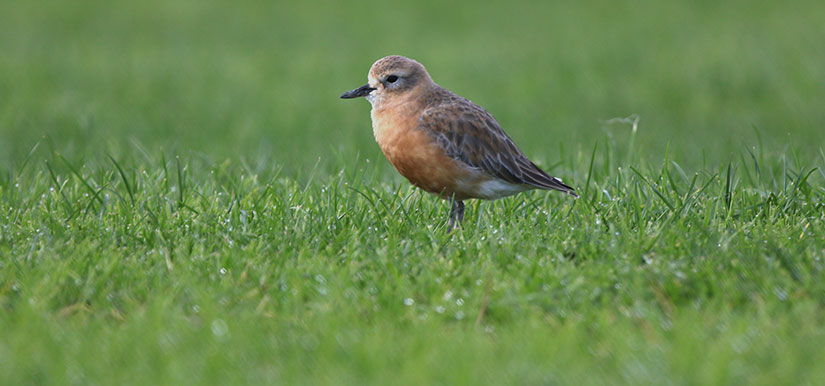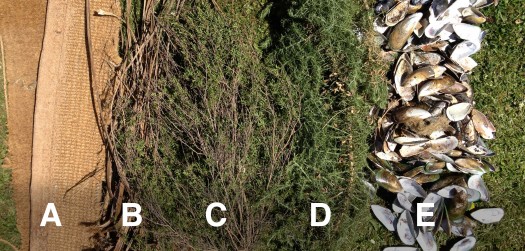We bought my dad a GoPro for his birthday
Seaweek
I went to a few events during Seaweek and spoke at one event (with some really inspirational people) about mussel reef restoration.
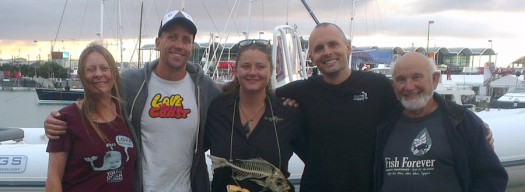
Inorganic rubbish collecting in Omaru creek

I had some help from Lucas this year and we pulled out some really big bits of trash. The most interesting thing being an entire cash register! I had pulled the shopping trolley in the photo out of the creek a few months ago when it first went in. I did call PAK’nSave and give them an address for where their expensive trolley was. Unfortunately it was eventually biffed back in the creek and is now ruined.
Australian droplet tunicate (Eudistoma elongatum) in Whangarei Harbour
So ugly, they look worse at low tide… sea snot. Amazing how dense the beds are given its only just been introduced to New Zealand. I guess we better get used to them.
Alexander Park Dotterel
Here is my unfinished report on the Dotterel breeding in Dotterel Alexandra Park. It has been circulated with management and they have told me the are producing a management plan.
Halos
As Council and DoC budgets get slashed it’s interesting to see local efforts emulating the success of the Wellingtons Halo project.
The Waitakere Ranges Halo Project
I am hoping this philanthropic partnership ( ZIP ) is a game changer.
Spat
An ASAP experiment designed to generate hunches not scientific facts.
This experiment is designed to answer:
- Is settlement attempted on filamentous structures around the Bastion reef?
- What kind of organic substrates do spat like?
- What size mesh best protects the spat from predators?
- Does raising the bed help settlement? (Presumably from sediment effects).
- How many holes can I put in my wetsuit in one outing?
Where
Bastion reef is ideal location because divers do not go there. The mussel population does not look to be harvested presumably because it is too close to city runoff. There are blue mussels present but there numbers are relativly low. It is also easily accessed by Kayak so I will not have to scratch anyones nice boat.
Design
Three cages 300x300x900mm (joined for stability) enclose 3 mixed bird netting wrapped bundels of test substrate at two different levels. The top level bundels (above 200mm) should be wire tied to the inside cage lids and should be at least Xmm above the sediment. The 3 mesh sizes test spotty predation the two heights test sediment effects.
“A 40mm spotty could eat a lot of spat”
- 5mm x 5mm plastic mesh. A 7mm tall spotty could get through on an angle.
- 12mm x 12mm square mesh. A 16mm tall spotty could get through on an angle.
- 40mm x 40mm square mesh. A 52mm tall spotty could get through on an angle.
A cow tag with a note about the experiment with my contact details was attached for curious divers (or if it gets washed up on the beach). Each bundle was clearly labled (cow tags) just incase they get mixed up.
Bricks(2) will be added inside the cages to compensate for the floatation provided by the plywood. Four large concrete block anchors attached by rope to the plywood and 20mm pegs should hold the cage still.
Materials:
- Galvanised 18G 1.25mm wire
- Countersunk stainless steel 316 grade 10g x 50mm decking screws
- Buttoned needle point 8g 13mm galvanised screws
- 23cm galvanised ground staples
- Square welded wire netting galvanised 12mm
- Square welded wire netting galvanised 25mm
- PE Gutter Guard 5mm
- 12mm CD Grade treated plywood
- 24mm treated plywood
- My wifes old metal shelving
- Shelves from my mother in laws old sun house
- Some staples and Nylon
- 4 concrete blocks
Settlement substrates
A. Coconut fibre (a door matt, welded with latex)
B. Cabbage tree leaves (long dead)
C. Manuka (fresh)
D. Gorse (seeding at collection time)
E. Mussel shell (fresh and old)

Substrates to try in the future:
- Manila rope
- Filamentous seaweed
- Feathers
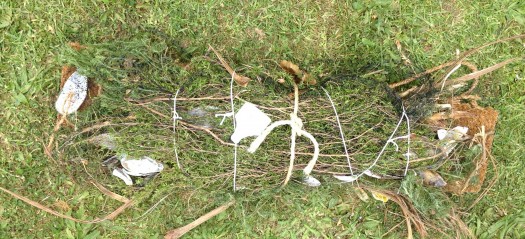
Each bundle was labeled:
BH BL SH SL CH CL
B=big S=small C=control H=high L=low
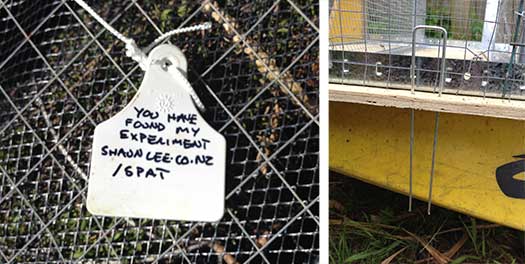
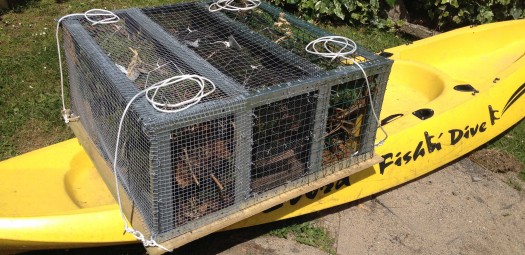
Deployed: 13 Dec 2014
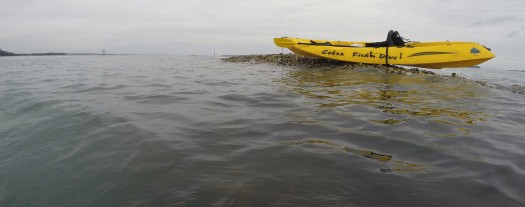 Just off the edge of the reef, on the southern side.
Just off the edge of the reef, on the southern side.
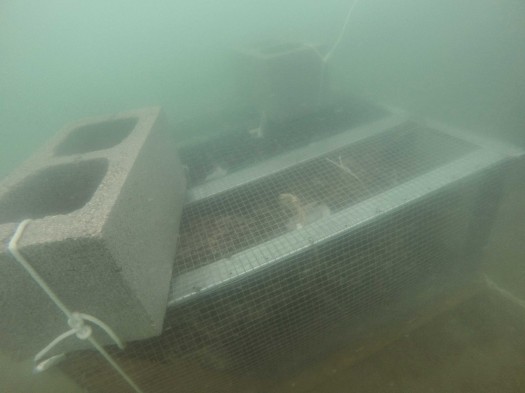
No holes in my wetsuit! (yet)
When
“Most spawning occurs in late spring to early autumn, but larvae can be present all year. Sexual maturity has been observed in some populations to begin from 27mm shell length, with most individuals sexually mature by 40mm shell length. Sexual maturity is reached in the first year, and females can produce up to 100 million eggs per season. Fertilisation is largely dependent on the proximity of adults.”
– http://fs.fish.govt.nz/Doc/5449/GLM_FINAL%2008.pdf.ashx
Monitoring
Check it once a month (take a brush to clean muck of cage surfaces), after 3 months or before the cage rusts too much the 6 bundels of substrate should be opened up on the beach. Each substrate photographed with a macro lense. Ideally it is then relocated somewhere with no mussels and no reef (for spotty to hide in) to see if transporting spat only to seed locations generates a mussel reef.
The photographs should be shown to marine scientist who can show me how identify spat. I can then count spat and work out spat per square cm or something.
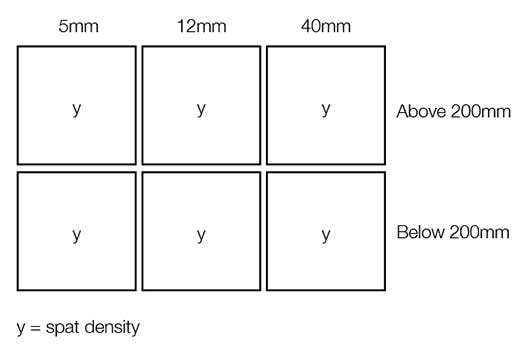
Prediction/ Prevention
- It will get washed away/ use bricks, peg it down & design it so wave action is likely to make it spin.
- It will sink into the mud/ wooden floor.
- It will get damaged by people/ add a note saying its an experiment and give them a URL.
- It will rust to bits/ check on it every month.
- Spotty still eat all the spat/ I have used the smallest mesh possible.
- Nothing/ leave it untill we have spat or it rusts away?
UPDATE: 14 Jan 2015
No movement of the cage. Lots of marine growth and sediment, several small spotty (I didn’t see any on installation). Cage cleaned off (a bit). I took this video pre-clean.
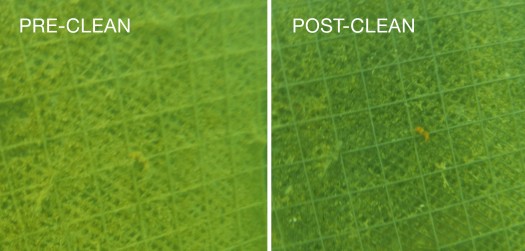
UPDATE: 14 Feb 2015
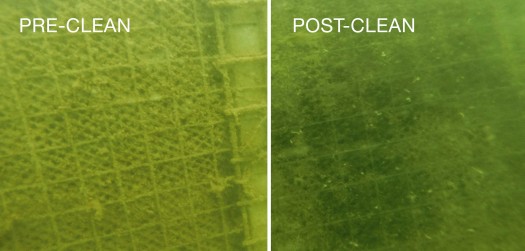
RESULTS: 05 March 2015
Cages opened, substrates well documented with macro lens. Not enough spat settlement for useful substrate observations.
OBSERVATIONS
Coir and cabbage tree leaves had the most suspect spat (I could not confirm without a microscope). Use a microscope to look for spat as you need to look at anything suspect from more than one angle.
The manuaka had the most hydroids (or fine branching structures) growing on it. This is significant as Hydroids are know settlement structures.
Several starfish including 11 arms in the control cage. Shrimps and all sorts of crabs but mostly half crabs and decorator crabs ,all sorts of young shells from whelks to turbans. Lots of other marine growth and invertebrates I could not identify.
Surprising lack of holes in my wetsuit! The hardest thing was lifting the bundles in trash bags back onto the boat by myself.
RECOMENDATIONS
The lack of settlement in all cages suggests spotty are not the main problem at this site. A cage placed higher up in the exposed tidal area would be interesting, as there must be settlement near the existing adult mussels (2 meters above where I had my cages).
UPDATE: Nov 2016
Worth noting nearly 2 years later that parts of the cages are still intact. There are beautiful hyrdroids and finger sponges growing on them and some not so welcome invasive clubbed tunicates. I noticed Mediterranean fanworm nearby and the entire green-lipped mussel reef has been devastated by human harvesting.
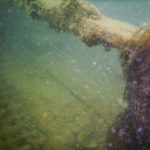
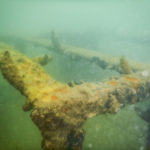
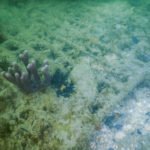
Good Nature Traps
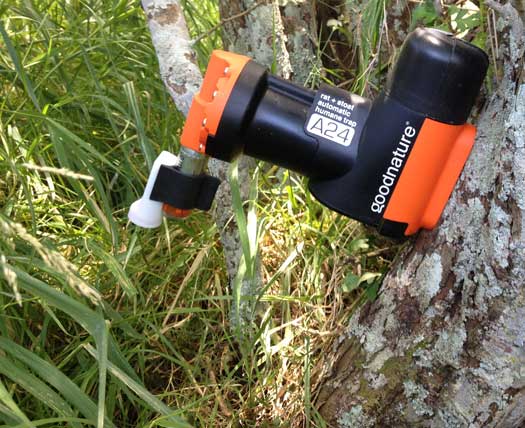
July 23 2014
Installed Good Nature A24 trap
August 6 2014
3 strikes recored no dead rats nearby
September 6 2014
5 strikes recorded no dead rats
November 5 2014
Replaced lure in trap
December 3 2014
Still says 5 strikes, replaced gas canister, tested (6 strikes)
December 10 2014
Gas canister says 7 strikes, no dead rat
December 17 2014
Gas canister says 9 strikes, still no dead rats

Early test correlates strikes more closely with canister replacement than lure replacement. Bodies may be removed by other predators, tho disposed bodies from other traps on this line tend to stay around. Strike counter checked weekly.
January 23 2015
Gas canister says 11 strikes, 1 dead rat!
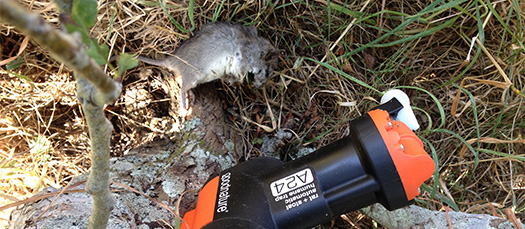
19 September 2015
Reset lure and new canister 3 weeks ago, 3 recorded kills – two rats and one mouse body lying on the ground! So awesome.
13 November 2016
I have had a look at my last two seasons of data and the A24 trap is outperforming my victor rat traps at 4 kills to one just based on the body counts. If I counted strikes (assuming bodies were being removed) then it might be even eight times more effective.
Great product, definitely worth the extra money. Go buy one.
Worst nest ever
Two things about signs


